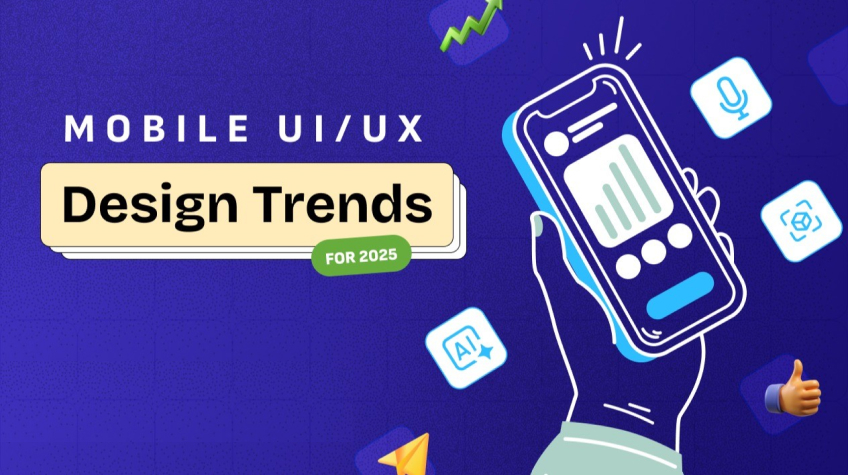
Mobile app design is changing incredibly fast, and every year we see new trends that influence user experiences and how we interact with digital interfaces. With 2025 on the horizon, designers are exploring the intersection of creativity and technology in new and exciting ways, bridging the gap between functionality and aesthetics and existing apps that are just as intuitive as they are beautiful to look at. In this blog, we will explore the best of UI/UX mobile app design trends for mobile apps that are expected to rule the digital world in 2025.
A major transformation in mobile app design will sweep through 2025 because of developing technologies, changing user behaviour, and shifting user requirements. Today’s mobile applications function as more than tools as they use progressive design techniques to create highly engaging experiences with tailored implementations for individual users.
The upcoming trends in UI/UX mobile app design trends for 2025 focus on producing user-friendly and visually attractive interfaces that incorporate augmented reality while having AI capabilities for personalized interactions. Understanding this trendset will help designers, developers, and business owners maintain their lead in digital markets which continue to grow more challenging.
Top 10 UI/UX Mobile App Design Trends
1. Neumorphism: The Revival of Soft UI
Neumorphism, which gained gradual adoption since 2019, will become mainstream design by 2025. The mobile app design trend unites skeuomorphic realistic design features with flat elements to generate a futuristic and soft appearance. A primary neuromorphic principle consists of implementing soft shadows with gentle gradients that generate simulated depth features as if they are gently raised or pressed into the background.
Mobile application users experience a sense of touch because neumorphism design elements enhance buttons, icons, and cards for more interactive features. Neumorphism adds physically accessible elements in the app interface to let users experience interactive features that support better usability. However, usage of neumorphism elements should remain selective because excessive application leads to interface disorganization.
2. Voice User Interface (VUI) Integration
Voice assistants Siri, Alexa, and Google Assistant have already become essential parts of how we interact daily. Mobile app design trends will heavily depend on voice user interfaces (VUI) as the new standard by the year 2025. The integration of voice commands will become more widespread in apps to deliver enhanced user experiences by letting users guide through the applications, select options and execute intricate tasks without manual interaction.
The mobile app accessibility improves in practical ways because users with disabilities or those on the move can utilize their mobile applications effortlessly through this trend. By 2025, Mobile apps will commonly use voice search technology with voice commands for control elements and voice-based personalization features, which will provide users with an immersive interactive experience because of the rising demand for voice control systems.
3. Dark Mode: A User-Centered Revolution
Mobile app design trends in 2025 will achieve novel heights through dark mode design trends that gained popularity in recent years. The user-centered methodology of dark mode helps users by reducing eye strain and offering longer OLED screen battery performance. Dark mode provides more benefits than simple personalization since it improves accessibility through visible content and better text readability in dim lighting.
The future mobile apps will automatically transform their designs according to lighting conditions instead of relying on static dark mode toggle options. Designers will investigate fresh palette options and accent colors to create dark mode versions that provide visual elegance as well as operational efficiency.
4. Personalized and Context-Aware Designs
The principal transformation in the mobile app design trend involves developing customized interfaces that specialize in user-specific contexts. The integration of artificial intelligence (AI) with machine learning technology in 2025 will allow apps to generate interfaces that match each user’s preferences, combined with their behavioral patterns and environmental variables.
An app demonstrates this capability by transforming its screen layout according to where you are located as well as the time you use it and your ongoing activity. Within the day the fitness app shows separate content while the news app chooses breaking news announcements during peak time periods.
5. Microinteractions for Enhanced Engagement
Small user interface components known as microinteractions exist to offer instant responses and produce delicate features for improving the overall application experience. Button animations with loading spinners and swipe gestures give the app its life despite seeming insignificant in function.
The design of microinteractions will advance in 2025 through the implementation of special animated visuals, haptic feedback systems and audio responses that will make interfaces more vivid according to projections. The designed interactions through the application generate a deeper user experience, combined with immediate feedback for users’ performed activities.
6. Augmented Reality (AR) and Immersive Experiences
Augmented reality (AR) will experience explosive growth worldwide during the year 2025. Shifts in AR technology will drive mobile applications toward implementing AR interfaces for blending digital content with real environments. The mobile app design user experience transforms because AR implements virtual try-ons in retail applications and real-time location-specific experiences.
The consumer adoption of enhanced reality solutions will become popular in sectors including gaming, medical care, education and retail establishments. Users in the retail industry can preview products in their homes using AR before making buying decisions. Gaming industry users will experience new game interactions through AR technologies. The integration of AR technology provides mobile app design with a futuristic quality that adds an entirely new interactive experience for users.
7. Minimalistic and Clean Designs
The design field now concentrates on simplicity and clarity because mobile devices continue to gain power. The Mobile App design trend for 2025 positions minimalism and cleanness as main themes, while designers work to remove all extraneous elements that might create visual clutter. Making your designs minimalist does not require less functionality, since it offers users a natural interface that guides them toward essential features.
The user’s goal of achieving uninterrupted usability drives this design direction. Mobile designers will make displays more organized through functional aesthetic design while screens expand in size. All interface elements need to function as needed either for user navigation or displaying content or enabling interactive features.
8. AI-Powered Design Automation
Artificial intelligence transforms user experiences by changing the basic approach to designing applications. Design automation through AI will dominate in 2025 by facilitating designers to produce customized user interfaces at a large scale. AI tools can process user data while forecasting user behaviours, so they modify the UI to match individual requirements with real-time adjustments.
AI tools can generate adaptive colors schemes that match users based on their preference history and create changing layouts through past interaction patterns. Through AI, designers can build designs, which deliver accessible user experiences while responding to users with various needs.
9. 3D and Motion Graphics in Mobile App Design
The year 2025 will bring expansion of 3D and Motion Graphics Features into mobile app design. The combination of existing design elements in mobile applications will get boosted with faster processors and advanced graphics capabilities to allow designers the creation of complex dynamic 3D visuals for the user experience.
The combination of motion elements and 3D visual features will enhance app design aesthetics as well as create depth and interactivity that conventional designs cannot achieve. Apart from gaming apps and social media platforms, these effects will commonly appear in applications that strive to develop distinctive immersive experiences.
10. Sustainability and Eco-Conscious Design
The sustainability trend of 2025 will guide mobile app designers toward developing environmentally friendly mobile app design approaches for their products. Modern apps will implement environmental saving components and sustainable design measures to decrease both their influence on device batteries as well as their energy usage.
Designers choose eco-friendly materials and technologies for their Mobile app development while building their applications by selecting sustainable solutions whenever suitable. Sustainable design elements within applications benefit both the planet and modern users who prioritize environmental health. A mobile application dedicated to energy efficiency and sustainability promotion generates trust and loyalty among users who care about the environment.
Conclusion
In conclusion, top UI/UX mobile app design will advance in 2025 by accepting new technological developments, aesthetic innovations, and customer-focused practice methods. Neumorphism, voice user interfaces, dark mode, and augmented reality enable developers to create visually pleasant apps that also serve users through enhanced accessibility features and personalized interactions. Designers must understand these trends and stay updated with the latest technologies to Mobile App Design Cost that resonate with users and cut through in a more congested marketplace.






